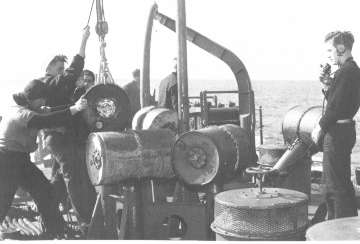U.S. Navy Depth
Charges
Types
The depth
charge is the most primitive dedicated ASW weapon. Even more primitive,
but not dedicated, are only ramming and gunning if the enemy is on the
surface; both variants of submarine "hunting" were exercised at all times
but were the only options available to a stunned Royal Navy in the first
three years of World War I.
It was
an extraordinarily crude weapon - basically just a can filled with explosives
and a hydrostatic fuze measuring the pressure of water around the weapon
and detonating it at a certain, pre-set depth. It was an okay weapon for
WWI - any attack would require the enemy to have been close to the surface,
so he could be seen, and the depths to which submarines might dive were
not great. The Royal Navy introduced the new weapon in 1916 and scored
the first success with it on December 13th, 1916, against UB-29, a German
submarine. Two depth charges had sufficed for her destruction, and indeed,
the numbers dropped for each kill in WWI gave a serious underappreciation
of what the Navy would need to drop in the future.
Two month
after that success, and even before the U.S. entered the war, the USN began
to develop a depth charge of their own, which was too weak to be successful.
However, after the U.S. entry, the Royal Navy provided an example of their
depth charges, which the U.S. fitted with a hydrostatic fuze of their own.
The final U.S. WWI depth charge could detonate at up to 300ft depth and
carried 300lbs explosives.
During the inter-war years,
there was little effort for better depth charges, but the 600lbs variant
was adopted for stern racks because of its better chance of success; the
300lbs variants were retained for the projectors.
WW2 started
for the ASW department with essentially the same weapon it had ended WWI
with, and development concentrated on increasing the depth in which a submarine
might be successfully attacked; coupled with that, the sinking speed of
the depth charges had to be increased.
The Mk
9 became the main variant. This was teardrop-shaped, capable of detonating
at 1000ft, and entered service in 1943. |
 Mk 6 type depth charges
and a K-gun aboard a U.S.
ASW patrol craft
in 1942.
Mk 6 type depth charges
and a K-gun aboard a U.S.
ASW patrol craft
in 1942.
|
In its original
form, it was not yet sufficently fast; modifications, such as lead ballast
and different fins were applied, finally reaching the goal. It did, however,
have to sacrifce explosive power and carried only 200lbs Torpex.
Magnetic depth charges were also tried, but
reliability problems precluded widespread use although the results obtained
were outstanding.
Depth
charges were abandoned by the U.S. Navy not much after World War II, the
Navy preferring torpedos and ahead thrown proximity & contact weapons.
Helicopters were the last U.S. weapons platform to retain depth charges,
and many brown-water navies continue to use the depth charge today, in
lieu of the hardly effective homing torpedos (since their sonar has problems
distinguishing the bottom of shallow waters from a potential target).
Useage
The standard method of deploying
a depth charge was by running it down a rail on the aft end of a ship.
Different depth charges would be set a different depths, so a nice pattern
would result and the submarine would, hopefully, end up in pieces.
This was a useful strategy in WWI, but a submarine could evade this if
it had already dived some time before. A more widespread pattern was needed
to catch such a target. The obvious solution to this problem was throwing
the depth charges far to the side, so as to create a sort of depth charge
carpet. For this purpose, the Y-gun was created.
This
was a projector, firing depth charges using a small explosive charge, located
on the centerline of a ship and having two "exits", forming a Y. On each
exit, a depth charge was tied, to be fired off in support of the other
charges, and landing some hundreds of yards outboard.
This was
an effective addition to the ASW forces, with one major flaw: it could
only be mounted on the centerline, a location were traditionally little
room is available.
Accordingly,
a split version of the Y-gun, the K-gun, was developed - it could be mounted
on the sides of the superstructure, firing one depth charge outboard.
Several
of these could be and were mounted on each destroyer. They were the fleet
destroyers' main and most effective ASW weapon, as those didn't receive
Hegehog. |
 A K-gun. Note the
short stump to the right of the projector's main arm, into which the explosive
charges were loaded.
A K-gun. Note the
short stump to the right of the projector's main arm, into which the explosive
charges were loaded.
|
|
Stats
|
Mk 6 (Early War)
Weight: 338 kg /
745lbs
Charge: 272 kg /
600lbs Torpex
Sinking Speed: 2.4m/s
/ 8f/s later mods (mid-1942) 3.7m/s / 12f/s
Depth: 9 - 91m /
30 - 300ft later mods (mid-1942) up to 183m / 600ft
Mk 9 (Late War)
Weight: ????
Charge: 91 kg / 200lbs
Torpex
Sinking Speed: 4.4m/s
/ 14.5f/s later mods (1944) 6.9m/s / 22.7f/s
Depth: 9 - 183m /
30 - 600ft |

